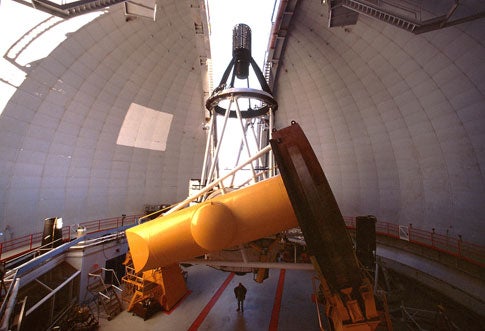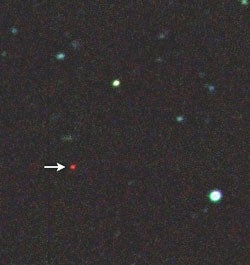A team of astronomers from Canada, France and the United States announced the discovery of a record-breaking black hole located nearly 13 billion light years from Earth. Details of the discovery, made with the Canada-France-Hawaii Telescope, were presented today by Dr. Chris Willott, of the University of Ottawa, to astronomers and astrophysicists during the annual conference of the Canadian Astronomical Society (CASCA 2007) in Kingston, Ontario. Future observations of this black hole will shed light on the early evolution of the Universe.
The black hole was discovered because when a black hole sucks gas towards it, the gas heats up and glows very brightly, allowing it to be seen at vast distances from Earth. This type of black hole is known as a quasar.
The record-breaking black hole was found from a new survey for distant quasars called the Canada-France High-z Quasar Survey (CFHQS), which uses the MegaCam imager on the MegaPrime focus of the Canada-France-Hawaii Telescope (CFHT).
The impressive set of data from MegaCam contains over 10 million stars and galaxies. Astronomers had to search the data carefully to distinguish the four distant quasars from the ordinary stars and galaxies. The most distant quasar has been named CFHQS J2329-0301 after the survey name and its coordinate position in the sky, which is in the constellation Pisces.
The team used the 8-meter (320-inch) Gemini-South Telescope in Chile to take a spectrum of the quasar. The distance to the quasar was determined by measuring an emission line in the spectrum, which showed that the quasar has a redshift of 6.43. “As soon as I saw the spectrum with its booming emission line, I knew this one was a long way away,” Willott said.
CFHQS J2329-0301 is so far away that the light we detect from it on Earth has been traveling through intergalactic space for nearly 13 billion years. Because the Big Bang occurred 13.7 billion years ago, this means that we see the quasar as it was less than 1 billion years after the Big Bang. This ‘time travel’ trick allows astronomers a direct view of what happened in the universe’s past.
The importance of this discovery lies in the fact that the furthest quasar from Earth is the closest in time to the beginning of the universe. The previous record-holder, called SDSS J1148+5251, was discovered in 2003 and is 2 million light years closer than CFHQS J2329-0301.
During most of the first billion years after the Big Bang, theory tells us that the universe was dark because there were no stars or galaxies and the atoms were all neutral. Then, sometime around the one billion year mark, the first stars and galaxies shone and the light from them caused a process known as the reionization of the universe, when all the atoms became ionized. The quest to understand and pinpoint the timing of this event is one of the major goals in astronomy today. Future observations will tell us if the gas in front of this quasar has been ionized or not.
The black hole powering the quasar is thought to have about 500 million times the mass of our own Sun. “It is puzzling how such enormous black holes are found so early on in the history of the universe, because we believe that black holes take a long time to grow,” said team member Dr. John Hutchings of the National Research Council Canada’s Herzberg Institute of Astrophysics.
Dr. Alain Omont of the Institut d’Astrophysique de Paris (Université Pierre et Marie Curie, CNRS), also a member of the team, said, “As well as using the quasar to study the reionization of the universe, we can also use it to locate one of the first high-mass galaxies that formed in the universe.” He notes that the previous record holding quasar, SDSS J1148+5251, led to many significant discoveries by astronomers making follow-up observations from telescopes located all over the world and in space. “We want to find out what sort of galaxy this black hole lives in,” he said.
The team is now planning to make further observations of the quasar. “The first thing we plan to do is get an infrared spectrum to refine the redshift,” Willott said. “Then we will see what this quasar can tell us about reionization and the growth of the first black holes and galaxies.”
Dr. Christian Veillet, CFHT’s Director, added, “Four quasars at redshift above 6 have already been discovered only half-way through the completion of the CFHQS and with incomplete follow-up; there are more to come in the next years. With this discovery, CFHT’s 3.6-meter telescope confirms its position at the forefront of wide-field imaging of the remote universe. It also demonstrates the power of a relatively modest-sized telescope like CFHT as a discovery machine feeding 8- to 10-meter class telescopes with exciting objects to follow-up.”











